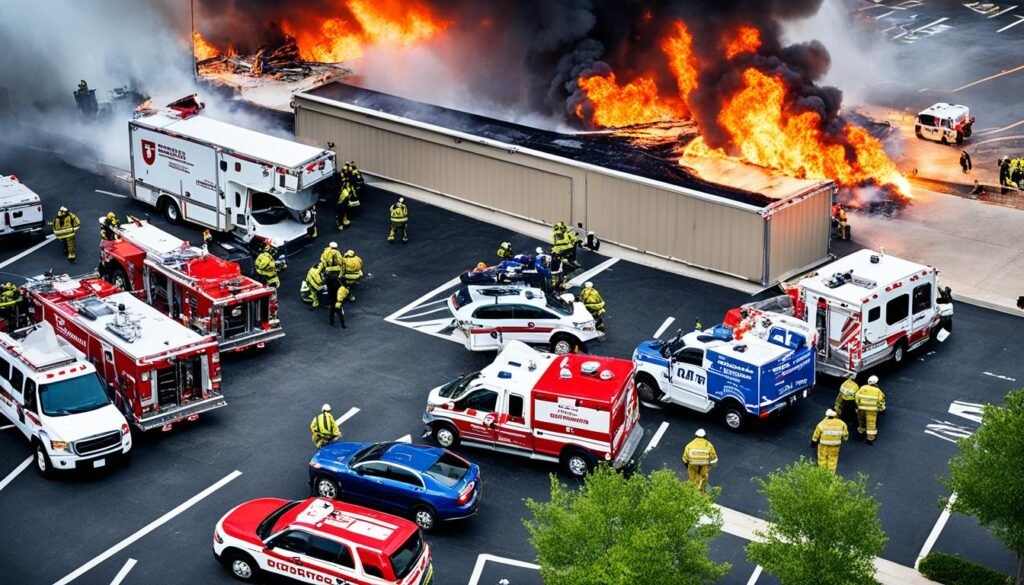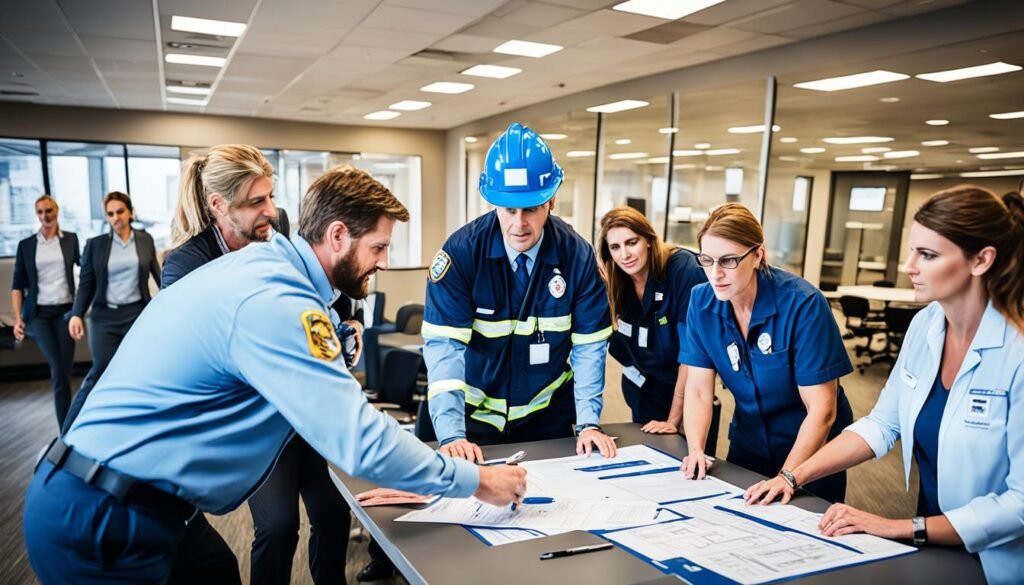About 40% of businesses close forever after a huge disaster. This includes natural and human-caused emergencies. So, it’s very important for companies to be ready for emergencies and have a strong plan to handle crises.
Keeping your employees, contractors, and visitors safe should be your main goal during an emergency. You need effective safety training, clear emergency plans, trustworthy alert systems, and good communication. To do this well, businesses should use a 10-step process to make an emergency plan. This process helps with checking resources, spotting dangers, and practicing drills.
Key Takeaways
- About 40% of businesses don’t open again after a big disaster.
- Being prepared for emergencies and having a strong crisis plan are key to staying open.
- Make sure the safety of employees, contractors, and visitors is a priority in emergencies.
- Put together a detailed emergency plan by following a 10-step guide.
- Practice with training drills and have clear ways to communicate.
Steps to Develop an Emergency Response Plan
It’s vital for businesses to have a strong emergency response plan. This ensures the safety of everyone during a crisis. Here are the key steps to make a good plan:
- Establish a Planning Team: Start by creating a team. This group will focus on the plan. They should come from different parts of the company like management, operations, and HR.
- Analyze Capabilities and Hazards: Check what resources you have. Identify any hazards related to your business or location. This helps in making strategies to lower risks.
- Develop the Plan: Use the information gathered to make your emergency plan. It should be clear and easy to find for everyone at work.
- Implement the Plan: Share the plan with all workers. Make sure they know what to do in an emergency. Training is essential for understanding the plan.
- Review Performance Objectives: Regularly check if the plan is working. Set goals and watch the progress. Update the plan as needed.
- Assess Available Resources: Always know what emergency tools and supplies you have. They should be ready to use whenever needed.
- Develop Hazard and Threat-Specific Emergency Procedures: Make specific plans for different dangers. This makes sure you’re ready for any situation.
- Establish Communication Protocols: Good communication is key in a crisis. Decide how you will inform people in the building, contact emergency services, and talk within your company.
- Training Personnel: Train employees regularly on emergency roles and actions. Practice drills to get better prepared.
- Utilize Emergency Planning Resources: Use planning guides and guidelines available. They offer valuable advice to make your plan better.
By doing these steps and always improving your plan, your business can handle emergencies better. You’ll protect lives, prevent injuries, and save property. Remember, looking out for your employees’ safety is key to a strong and ready organization.
| Emergency Response Plan Key Steps | Benefits |
|---|---|
| Establish a Planning Team | Ensures diverse perspectives and expertise are considered during plan development. |
| Analyze Capabilities and Hazards | Identifies potential risks and vulnerabilities, enabling effective risk mitigation. |
| Develop the Plan | Provides a clear roadmap for responding to emergencies, minimizing confusion. |
| Implement the Plan | Ensures everyone is aware of their roles and responsibilities, improving response effectiveness. |
| Review Performance Objectives | Allows for ongoing evaluation and improvement of the emergency response plan. |
| Assess Available Resources | Ensures necessary equipment and supplies are readily available when needed. |
| Develop Hazard and Threat-Specific Emergency Procedures | Enables tailored responses to different types of emergencies, maximizing effectiveness. |
| Establish Communication Protocols | Facilitates timely and effective communication during emergencies, reducing response time. |
| Training Personnel | Ensures employees are prepared and confident in their response actions, minimizing panic and errors. |
| Utilize Emergency Planning Resources | Access to best practices and guidelines to enhance plan effectiveness and response capabilities. |
The Role of Emergency Management in Business Preparedness
Emergency management is key to protecting your business and everyone involved. It’s about knowing the risks and making a plan to handle emergencies. This plan should fit into your company’s daily activities, making you ready for any crisis.
Identifying dangers is a big part of hazard identification. You need to know the risks your business could face, from inside and outside. A deep dive into these risks helps you spot weak spots in your protection.
A good emergency plan covers a lot. It starts with an executive summary, giving a quick look at the main goals and tactics. You also need clear emergency response procedures. They outline exact steps for different emergencies. This way, everyone knows what to do when trouble hits. Back-up documents like contact lists and incident reports boost your plan’s strength.
Training and exercises are crucial. They teach your team what to do in an emergency. Regular drills mimic real-life crises. This helps everyone brush up on what to do and find areas to get better at.
Merging your emergency plan with company operations is vital. It should blend with your day-to-day work. Everyone should be familiar with the plan and ready to act on it if needed.
Keeping your emergency plan fresh is critical. As your business grows, so do new risks. Updates in tech or how you work might happen. Regular checks and tweaks keep your plan sharp and suitable for new challenges.

In summary, strong emergency management is a must for keeping your business safe. It’s about spotting risks, making a detailed plan, training, and blending this plan into daily work. Staying ahead in emergency preparedness means your business can face hard times head-on, keeping people safe and the company running smoothly.
Conclusion
Business Emergency Response Safety is key to being ready for crises at work. By making an emergency plan and checking for hazards, businesses get better at handling emergencies. It’s also important to set up ways to communicate and to train everyone well.
Businesses need to keep their employees and visitors safe. They do this by having good emergency plans. Keeping the business running during hard times is essential.
Always be ready and prepared. This helps reduce the effects of emergencies on your organization. Stay alert and keep your emergency plan up-to-date. Make sure your team is well-trained to act fast and effectively when needed.


